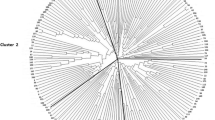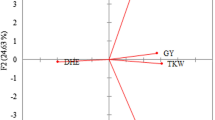Abstract
Crop landraces represent a source of useful genes endowing tolerance to biotic and abiotic stresses, and other agronomic traits including yield. Our study involved 446 Afghan wheat (Triticum aestivum L.) landraces collected from 16 provinces during three Japanese scientific expeditions in 1955, 1967, and 1979. The landraces and varieties were genotyped using 30,000 diversity array technology (DArT) genetic markers, of which 15,817 were polymorphic. The landraces were grouped into 15 subpopulations based on population structure and phylogenetic studies. DArT markers were used to group landraces based on their origins or collection sites and to differentiate East Asian genotypes, CIMMYT lines, and modern Afghanistan cultivars from Afghan landraces. The Afghan landraces were highly diverse compared with lines from other origins. These landraces seem to possess unique genes that might allow enrichment of the global wheat gene pool and improvements in wheat production worldwide. Our next objective is to identify genotypes with promising attributes and to conduct association mapping studies focusing on biotic and abiotic stresses.



Similar content being viewed by others
References
Akbari M, Wenzl P, Caig V, Carng J, Xia L, Yang S, Uszynski G, Mohler V, Lehmensiek A, Kuchel H, Hayden MJ, Howes N, Sharp P, Vaughan P, Rathmell B, Huttner E, Kilian A (2006) Diversity arrays technology (DArT) for high-throughput profiling of the hexaploid wheat genome. Theor Appl Genet 113:1409–1420
Bonman JM, Bockelman HE, Jin Y, Hijmans RJ, Gironella A (2007) Geographic distribution of stem rust resistance in wheat landraces. Crop Sci 47:1955–1963
Buerkert A, Oryakhail M, Filatenko AA, Hammer K (2006) Cultivation and taxonomic classification of wheat landraces in the upper Panjsher valley of Afghanistan after 23 years of war. Genet Resour Crop Evol 53:91–97
Crossa J, Burgueno J, Dreisigacker S, Vargas M, Herrera-Foessel SA, Lillemo M, Singh RP, Trethowan R, Warburton M, Franco J, Reynolds M, Crouch JH, Ortiz R (2007) Association analysis of historical bread wheat germplasm using additive genetic covariance of relatives and population structure. Genetics 177:1889–1913
Dreisigacker S, Zhang P, Warburton ML, Ginkel MV, Hoisington D, Bohn M, Melchinger AE (2004) SSR and pedigree analyses of genetic diversity among CIMMYT wheat lines targeted to different mega environments. Crop Sci 44:381–388
Falush D, Stephens M, Pritchard JK (2003) Inference of population structure using multilocus genotype data: linked loci and correlated allele frequencies. Genetics 164:1567–1587
Feldman M (2001) Origin of cultivated wheat. In: Bonjean AP, Angus WJ (eds) The world wheat book: a history of wheat breeding. Lavoisier Publishing, Paris, pp 3–53
Francki MG, Walker E, Crawford AC, Broughton S, Ohm H, Barclay I, Wilson R, McLean R (2009) Comparison of genetic and cytogenetic maps of hexaploid wheat (Triticum aestivum L.) using SSR and DArT markers. Mol Genet Genomics 281:181–191
Ghimire SK, Akashi Y, Maitani C, Nakanishi M, Kato K (2005) Genetic diversity and geographical differentiation in Asian common wheat (Triticum aestivum L.), revealed by the analysis of peroxidase and esterase isozymes. Breed Sci 55:175–185
Helbaek H (1959) Domestication of food plants in the old world. Science 130:365–372
Hirano R, Kikuchi A, Kawase M, Watanabe KN (2008) Evaluation of genetic diversity of bread wheat landrace from Pakistan by AFLP and implications for a future collection strategy. Genet Resour Crop Evol 55:1007–1015
Jaccoud D, Peng K, Felnstein D, Killian A (2001) Diversity arrays: a solid state technology for sequence information independent genotyping. Nucleic Acids Res 29:e25
Kihara H (1944) Discovery of the DD-analyser, one of the ancestors of Triticum vulgare. Agric Hortic 19:13–14
Kilian A, Huttner E, Wenzl P, Jaccoud D, Carling J, Caig V, Evers M, Heller-Uszynska K, Cayla C, Patarapuwadol S, Xia L, Yang S, Thomson B (2005) The fast and the cheap: SNP and DArT-based whole genome profiling for crop improvement. In: Tuberosa R, Phillips RL, Gale M (eds) Proceedings of the international congress “In the wake of the double helix: from the green revolution to the gene revolution”, 27–31 May 2003. Avenue Media, Bologna, pp 443–461
Li YH, Guan RX, Liu ZX, Ma YS, Wang LX, Li LH, Lin FY, Luan WJ, Chen PY, Yan Z, Guan Y, Zhu L, Ning XC, Smulders MJ, Li W, Piao RH, Cui YH, Yu ZM, Guan M, Chang RZ, Hou AF, Shi AN, Zhang B, Zhu SL, Qiu LJ (2008) Genetic structure and diversity of cultivated soybean (Glycine max (L.) Merr.) landraces in China. Theor Appl Genet 117:857–871
Maccaferri M, Sanguineti MC, Noli E, Tuberosa R (2005) Population structure and long-range linkage disequilibrium in a durum wheat elite collection. Mol Breed 15:271–289
Marone D, Panio G, Ficco DBM, Russo MA, De Vita P, Papa R, Rubiales D, Cattivelli L, Mastrangelo AM (2012) Characterization of wheat DArT markers: genetic and functional features. Mol Genet Genomics 287:741–753. doi:10.1007/s00438-012-0714-8
Mujeeb-Kazi A, Rosas V, Roldan S (1996) Conservation of the genetic variation of Triticum tauschii in synthetic hexaploid wheats and its potential utilization for wheat improvement. Genet Resour Crop Evol 43:129–134
Neumann K, Kobiljski B, Dencic S, Varshney RK, Borner A (2010) Genome-wide association mapping: a case study in bread wheat (Triticum aestivum L.). Mol Breed 27:37–58
Pritchard JK, Rosenberg NA (1999) Use of unlinked genetic markers to detect population stratification in association studies. Am J Hum Genet 65:220–228
Pritchard JK, Stephens M, Donnelly P (2000) Inference of population structure using multilocus genotype data. Genetics 155:945–959
Raman H, Stodart BJ, Cavanagh C, Mackay M, Morell M, Milgate A, Martin P (2010) Molecular diversity and genetic structure of modern and traditional landrace cultivars of wheat (Triticum aestivum L.). Crop Pasture Sci 61:222–229
Reynolds M, Dreccer MF, Trethowan R (2007) Drought-adaptive traits derived from wheat wild relatives and landraces. J Exp Agric 58:177–186
Ruiz M, Giraldo P, Royo C, Villegas D, Aranzana MJ, Carrillo JM (2012) Diversity and genetic structure of a collection of Spanish durum wheat landraces. Crop Sci 52:2262–2275
Sharma KS, Habibi HK (2013) Wheat secure Afghanistan: assessing priorities. Wheat Inf Serv 115:11–15. www.shigen.nig.ac.jp/ewis
Smale M (1996) Understanding global trends in the use of wheat diversity and international flows of wheat genetic resources. Economics Working Paper 96-02. Mexico, DF, CIMMYT
Smale M (1997) The green revolution and wheat genetic diversity. Some unfounded assumptions. World Dev 25:1259–1269
Sohail Q, Shehzad T, Kilian A, Eltayeb AE, Tanaka H, Tsujimoto H (2012) Development of diversity array technology (DArT) markers for assessment of population structure and diversity in Aegilops tauschii. Breed Sci 62:38–45
Stodart BJ, Mackay MC, Raman H (2007) Assesment of molecular diversity in landraces of bread wheat (Triticum aestivum) held in an ex situ collection with Diversity Arrays Technology (DArT). Aust J Agric Res 58:1174–1182
Terasawa Y, Kawahara T, Sasakuma T, Sasanuma T (2009) Evaluation of the genetic diversity of an Afghan wheat collection based on morphological variation, HMW glutenin subunit polymorphisms, and AFLP. Breed Sci 59:361–371
Vavilov NI, Bukinich DD (1929) Agricultural Afghanistan. Bull Appl Bot Genet Plant Breed Supp 33:378–382, 474, 480, 584–585, 604 (in Russian)
Wenzl P, Carling J, Kudrna D, Jaccoud D, Huttner E, Kleinhofs A, Kilian A (2004) Diversity arrays technology (DArT) for whole-genome profiling of barley. Proc Natl Acad Sci USA 101:9915–9920
White J, Law JR, MacKay I, Chalmers KJ, Smith JSC, Kilian A, Powell W (2008) The genetic diversity of UK, US and Australian cultivars of Triticum aestivum measured by DArT markers and considered by genome. Theor Appl Genet 116:439–453
Zeven AC (1998) Landraces: a review of definitions and classification. Euphytica 104:127–139
Zhang LY, Liu DC, Guo XL, Yang WL, Sun JZ, Wang DW, Sourdille P, Zhang AM (2011) Investigation of genetic diversity and population structure of common wheat cultivars in northern China using DArT markers. BMC Genet 12:42
Acknowledgments
The study was conducted under the aegis of the SATREPS-Afghan project supported by Japan Science and Technology and Japan International Co-operation Agency. We offer special thanks to Dr. Kenji Komatsu for his valuable contributions to the initial stages of sample collection.
Conflict of interest
No author has any possible conflict of interest.
Author information
Authors and Affiliations
Corresponding author
Electronic supplementary material
Below is the link to the electronic supplementary material.
10722_2015_219_MOESM1_ESM.pdf
Dendrogram showing diversity of Afghan wheat landraces. Each colour specify the major collection site. The year of collection and exact location also indicated in the figure (PDF 1434 kb)
10722_2015_219_MOESM2_ESM.pptx
Agro-ecological map of Afghanistan. Total area was divided into eight zones according to climate and crops grown (FAO). The number inside denotes each provinces (PPTX 377 kb)
Rights and permissions
About this article
Cite this article
Sohail, Q., Manickavelu, A. & Ban, T. Genetic diversity analysis of Afghan wheat landraces (Triticum aestivum) using DArT markers. Genet Resour Crop Evol 62, 1147–1157 (2015). https://doi.org/10.1007/s10722-015-0219-5
Received:
Accepted:
Published:
Issue Date:
DOI: https://doi.org/10.1007/s10722-015-0219-5




